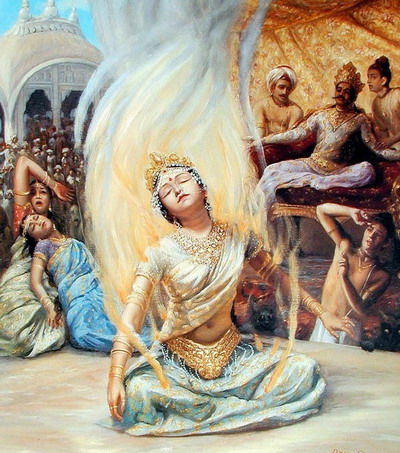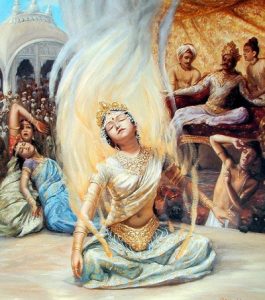The Sati Myth



Lets remember that long ago in Macadonia (Greece), the wife of King Philip, father of Alexander was buried with him as were wives and servants in Chinese culture.
You can ask any Hindu community if they know of any woman who has thrown herself into a funeral pyre and the answer is universally no. In fact the idea is seen as horrendous in all eyes, Hindu and otherwise. There may have been a few occasions in the distant past where this may have happened, yet it is so rare that records of it happening are non-existent so where does this myth come from?
While the burning passion of a woman can terrify strong men and the bliss of women like Sri Ma Anandamayi may invoke a shift in reality, the following points must be considered:
When we consider any of these elements within a poorly educated and connected society, and the fact that when information moves from one person to the next, it is often embellished or changed wilfully or otherwise. But let’s not forget, these things happened globally and not only in India.
The myth is set in India because such things have happened there and while sati is mentioned in Vedic texts, it was clearly disapproved of within Hindu society. In the Rig-Veda (10:18:8) there is a passage addressed to a widow at her husbands funeral pyre: “rise up, abandon this dead man and re-join the living”.
If Sati is not a Hindu practise, how has this misconception become so popular?
While sati did occur from Mogul times as a lesser fate prompting the Commission Of Sati (Prevention) Act enacted in 1988, to associate sati with Sanatana Dharma is a serious misconception. The wives of deceased Hindu heroes did not commit suicide and there are no assertations from Godly heroes like Rama and Krishna that women should do this. There is little doubt that travelling information is quickly distorted, quickly snapped up and utilised for political advantage as so often happens today. But the idea of sati was deliberately propagated by the British while they ruled over India, but rather than the smell of roasting flesh, it smells of a cook up orchestrated by the British East India company as another mechanism of control.
While they were building railways to export the produce of India in order to line their own pockets, they orchestrated disrespect of traditions and propagated falsehoods to divide the population, keep them passive and justify British rule to the Brits at home. In the colonial era, the British media used to deliberately propagate myths like Sati to paint Indians as a barbaric people who were incapable of self-rule, and therefore needed to be ruled by foreigners.
As Cambridge historian Mike Dash explains: “Suttee was not, in fact, particularly common.” But that was not the impression Britons received from their newspapers and books. Prurient reports from India spoke of women being forced shrieking onto their funeral pyres by baying relatives, and dwelled on the agonies of a slow death by fire; a good many readers with no personal knowledge of India believed that this was the common fate of all Hindu widows from Bombay to Bengal. The notion “profoundly shocked public opinion at home.”
There are too many propagandist views of Hinduism that are simply not true. The least we can do for ourselves is not be taken in by them. So when we hear that Hindu widows are supposed to burn themselves in the funeral pyre of their dead husbands, it should be recognised that what we are reading/listening to a piece of quasi-Imperialistic propaganda that should be firmly rejected.
Contrary reference; The Madras Courier
Credit; Hindu Perspective
Image; Tumblr images
DISCLAIMER: The author is solely responsible for the views expressed in this article. The author carries the responsibility for citing and/or licensing of images utilized within the text.
